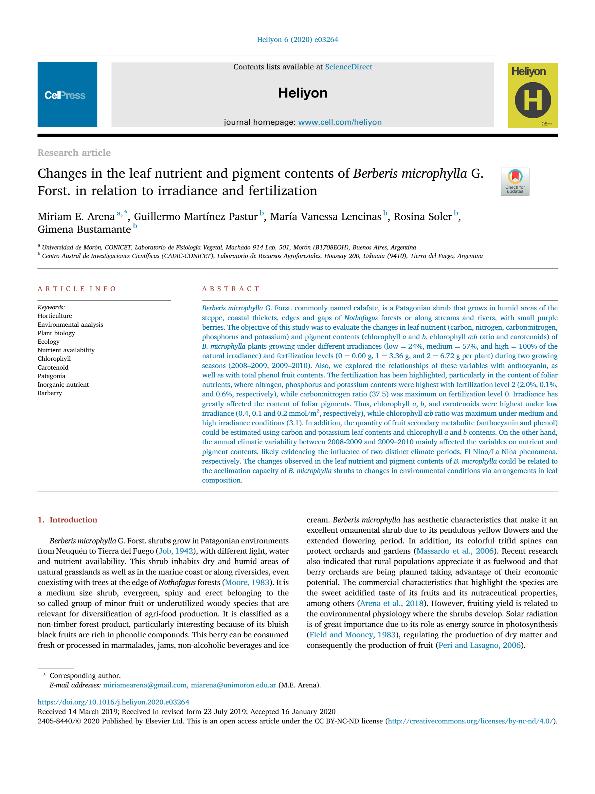Artículo
Changes in the leaf nutrient and pigment contents of Berberis microphylla G. Forst. in relation to irradiance and fertilization
Arena, Miriam Elisabet ; Martínez Pastur, Guillermo José
; Martínez Pastur, Guillermo José ; Lencinas, María Vanessa
; Lencinas, María Vanessa ; Soler Esteban, Rosina Matilde
; Soler Esteban, Rosina Matilde ; Bustamante, Gimena Noemi
; Bustamante, Gimena Noemi
 ; Martínez Pastur, Guillermo José
; Martínez Pastur, Guillermo José ; Lencinas, María Vanessa
; Lencinas, María Vanessa ; Soler Esteban, Rosina Matilde
; Soler Esteban, Rosina Matilde ; Bustamante, Gimena Noemi
; Bustamante, Gimena Noemi
Fecha de publicación:
01/2020
Editorial:
Elsevier
Revista:
Heliyon
ISSN:
0722-4060
Idioma:
Inglés
Tipo de recurso:
Artículo publicado
Clasificación temática:
Resumen
Berberis microphylla G. Forst. commonly named calafate, is a Patagonian shrub that grows in humid areas of the steppe, coastal thickets, edges and gaps of Nothofagus forests or along streams and rivers, with small purple berries. The objective of this study was to evaluate the changes in leaf nutrient (carbon, nitrogen, carbon:nitrogen, phosphorus and potassium) and pigment contents (chlorophyll a and b, chlorophyll a:b ratio and carotenoids) of B. microphylla plants growing under different irradiances (low = 24%, medium = 57%, and high = 100% of the natural irradiance) and fertilization levels (0 = 0.00 g, 1 = 3.36 g, and 2 = 6.72 g per plant) during two growing seasons (2008-2009, 2009-2010). Also, we explored the relationships of these variables with anthocyanin, as well as with total phenol fruit contents. The fertilization has been highlighted, particularly in the content of foliar nutrients, where nitrogen, phosphorus and potassium contents were highest with fertilization level 2 (2.0%, 0.1%, and 0.6%, respectively), while carbon:nitrogen ratio (37.5) was maximum on fertilization level 0. Irradiance has greatly affected the content of foliar pigments. Thus, chlorophyll a, b, and carotenoids were highest under low irradiance (0.4, 0.1 and 0.2 mmol/m2, respectively), while chlorophyll a:b ratio was maximum under medium and high irradiance conditions (3.1). In addition, the quantity of fruit secondary metabolite (anthocyanin and phenol) could be estimated using carbon and potassium leaf contents and chlorophyll a and b contents. On the other hand, the annual climatic variability between 2008-2009 and 2009-20101 mainly affected the variables on nutrient and pigment contents, likely evidencing the influence of two distinct climate periods, El Niño/La Niña phenomena, respectively. The changes observed in the leaf nutrient and pigment contents of B. microphylla could be related to the acclimation capacity of B. microphylla shrubs to changes in environmental conditions via arrangements in leaf composition.
Palabras clave:
Patagonia
,
Barberry
,
inorganic nutrient
,
chlorophyll
Archivos asociados
Licencia
Identificadores
Colecciones
Articulos(CADIC)
Articulos de CENTRO AUSTRAL DE INVESTIGACIONES CIENTIFICAS
Articulos de CENTRO AUSTRAL DE INVESTIGACIONES CIENTIFICAS
Articulos(SEDE CENTRAL)
Articulos de SEDE CENTRAL
Articulos de SEDE CENTRAL
Citación
Arena, Miriam Elisabet; Martínez Pastur, Guillermo José; Lencinas, María Vanessa; Soler Esteban, Rosina Matilde; Bustamante, Gimena Noemi; Changes in the leaf nutrient and pigment contents of Berberis microphylla G. Forst. in relation to irradiance and fertilization; Elsevier; Heliyon; 6; 1; 1-2020; 1-11
Compartir
Altmétricas



